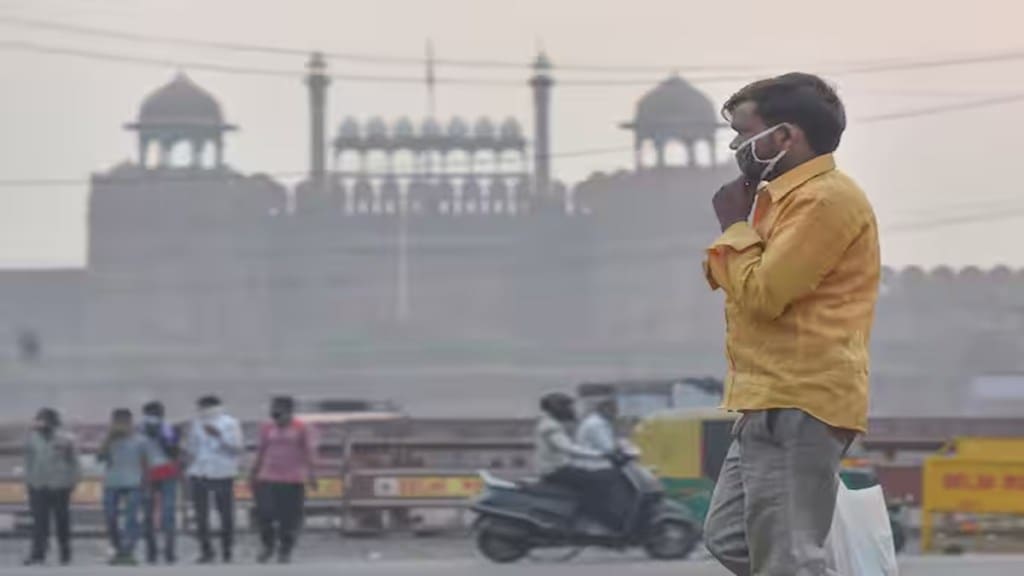The Air Quality Index (AQI) in Delhi-NCR hovered near the 500-mark on Monday even after imposition of GRAP-4. Banasree Purkayastha explains how the GRAP framework aims to combat air pollution, the restrictions under the fourth stage, and whether we can expect cleaner air soon
Why was GRAP-4 invoked?
Delhi’s average AQI had crossed the 450-mark on Sunday evening reaching the ‘severe-plus’ category, prompting the Commission for Air Quality Management (CAQM) to impose the fourth and most extreme stage of the Graded Response Action Plan (GRAP) from Monday. The capital city and its adjoining areas have been under a thick blanket of smog since November 13. But by Monday evening, Delhi’s AQI reading was at 493, the highest this season. At least four stations in Delhi had touched 500, with many others between 490-500. With visibility down to 150 metres due to the thick smog, around 14 flights were diverted to airports in neighbouring states.
On Monday, the Supreme Court, which is hearing a plea seeking directions to curb air pollution in the national capital and adjoining areas, said it would not allow scaling down of preventive measures under Stage-4 even if AQI goes below 450. Rebuking the Delhi government for delay in imposition of GRAP-4, it said that Stage-4 should come into effect once the AQI reaches between 300 and 400. “GRAP-4 will continue till court permits,” it said.
What is the GRAP framework?
GRAP was introduced as an emergency response mechanism, and its implementation is triggered in the capital and its vicinity when the AQI reaches “poor” levels during peak pollution season, typically October-November. The CAQM oversees the implementation of GRAP in collaboration with the ministry of environment, forest and climate change. First implemented in 2017, it classifies the air quality into four different stages: Stage-1 – ‘poor’ (AQI 201-300) with strict enforcement of regulations on overaged diesel and petrol vehicles; Stage-2 – ‘very poor’ (AQI 301-400) where actions focus on pollution hotspots and operational limits on diesel generators; Stage 3 – ‘severe’ (AQI 401-450) with stricter restrictions, including limiting the movement of specific vehicles and possibly online classes in schools; and Stage 4 – ‘severe plus’ (AQI above 450) which sees the implementation of the most stringent measures.
What does GRAP-4 mandate?
The GRAP-4 response encompasses an 8-point action plan designed to mitigate the pollution crisis. Key measures include banning the entry of trucks into Delhi except for those carrying essential commodities or providing essential services, besides extending the ban on construction and demolition activities to include public infrastructure projects like highways, roads, flyovers, and power transmission lines. Only LNG/ CNG/ electric and BS-VI diesel trucks are permitted into the city. Light commercial vehicles register-ed outside Delhi cannot enter the city, except those powered by electric, CNG, or BS-VI diesel engines. Delhi-registered BS-IV and below diesel-operated medium and heavy goods vehicles are also prohibited, except for those carrying essential services. Additional measures such as odd-even vehicle number scheme for plying in the city, closure of educational institutions and non-emergency commercial activities may be imposed based on state government orders. The CAQM has recommended that offices in the NCR work at 50% capacity, with the rest working from home. Classes are also moved online to protect children from exposure to the toxic air.
Why pollution levels are so high
Stubble burning by farmers in neighbouring states is considered to be the main reason behind Delhi’s annual date with hazardous air though vehicular emissions and unregulated construction activities releasing dust and other pollutants are also significant contributors. Stubble burning this season has contributed as much as 40% of Delhi’s pollution, as per SAFAR, a weather forecasting agency under the ministry of earth sciences. While stubble burning incidents in Punjab have come down from a high of 47,788 in 2022 to 8,404 in 2024 (September 15 to November 17 period), in Uttar Pradesh it has gone up from 1,555 to 2,807 during the same period. At the same time, there are reports that farmers have been strategically timing their burning activities to avoid detection by satellite monitoring systems.
Delhi’s geographical location and low temperatures every winter also provide the perfect environment for hazardous smog. Low wind speeds, temperature inversions in which a layer of cool air forms near the ground and heavy fog trap dust and pollutants leading to a thick layer of toxic smog to envelop the city.
Can we expect any respite soon?
While the CAQM attributed the sudden spike in pollution levels to continuing unfavourable meteorological conditions, it has said “…the average AQI for Delhi is expected to remain in this adverse range owing to heavy fog, variable winds, highly unfavourable meteorological and climatic conditions.” Forecasts from the India Meteorological Department /Indian Institute of Tropical Meteorology also indicate a likelihood of the AQI to particularly remain in the higher end of ‘severe’ or ‘severe-plus’ category in the coming days, owing to climatic conditions unfavourable to dispersion of air pollutants.

